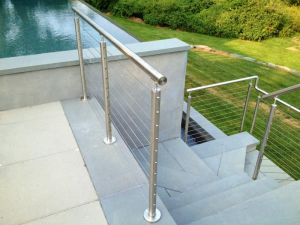Understanding the Codes Affecting Cable Railing Systems
Cable railing systems, known for their sleek and modern aesthetic, are popular in residential and commercial settings. They provide unobstructed views while ensuring safety for staircases, balconies, and decks. However, installing cable railing requires adherence to specific building codes, which vary depending on the location and application.
 1. International Building Code (IBC) and International Residential Code (IRC)
1. International Building Code (IBC) and International Residential Code (IRC)
Height Requirements: The IBC and IRC mandate that railings, including cable railings, must be at least 42 inches high for commercial (IBC) and 36 inches for residential (IRC) applications.
Cable Spacing and Tension: The codes specify the maximum spacing between cables to prevent large gaps that could allow a person (particularly a small child) to slip through. Typically, the maximum allowed space is 4 inches, which aligns with the “4-inch sphere rule” designed to prevent children from fitting through the cables.
Load Requirements: Railings must withstand a certain amount of load without failing. For example, the IBC requires guardrails and handrails to withstand a minimum load of 50 pounds per linear foot (plf) applied horizontally or vertically to the top of the rail.
2. Material and Installation Codes
The choice of materials and the method of installation also affect the compliance of cable railings with local building codes:
Material Durability: Cable railings must be made from durable and weather-resistant materials, especially in outdoor settings. Stainless steel cables are commonly used because of their strength and resistance to corrosion.
Installation Standards: Proper tensioning of cables is crucial to maintain the required spacing and load-bearing capacity. Incorrectly tensioned cables can lead to sagging, which could compromise safety and fail to meet code requirements.
3. Periodic Inspection and Maintenance
Regular inspections and maintenance are recommended to ensure that cable railings remain in good condition and compliant with codes over time. This can include checking for cable tension, material wear, and overall stability of the installation.
The design and installation of cable railings are heavily influenced by various building codes aimed at ensuring safety and accessibility. Whether you are a homeowner looking to install a new railing system, or a professional in the building industry, understanding and adhering to these codes is essential for a compliant and safe installation. As always, when planning to install cable railings, consulting with a professional to ensure all local codes and regulations are met is advised. This not only ensures safety but also enhances the aesthetic and functional value of the property.

 +86 159 6420 9667
+86 159 6420 9667  sales@haxrailing.com
sales@haxrailing.com 



